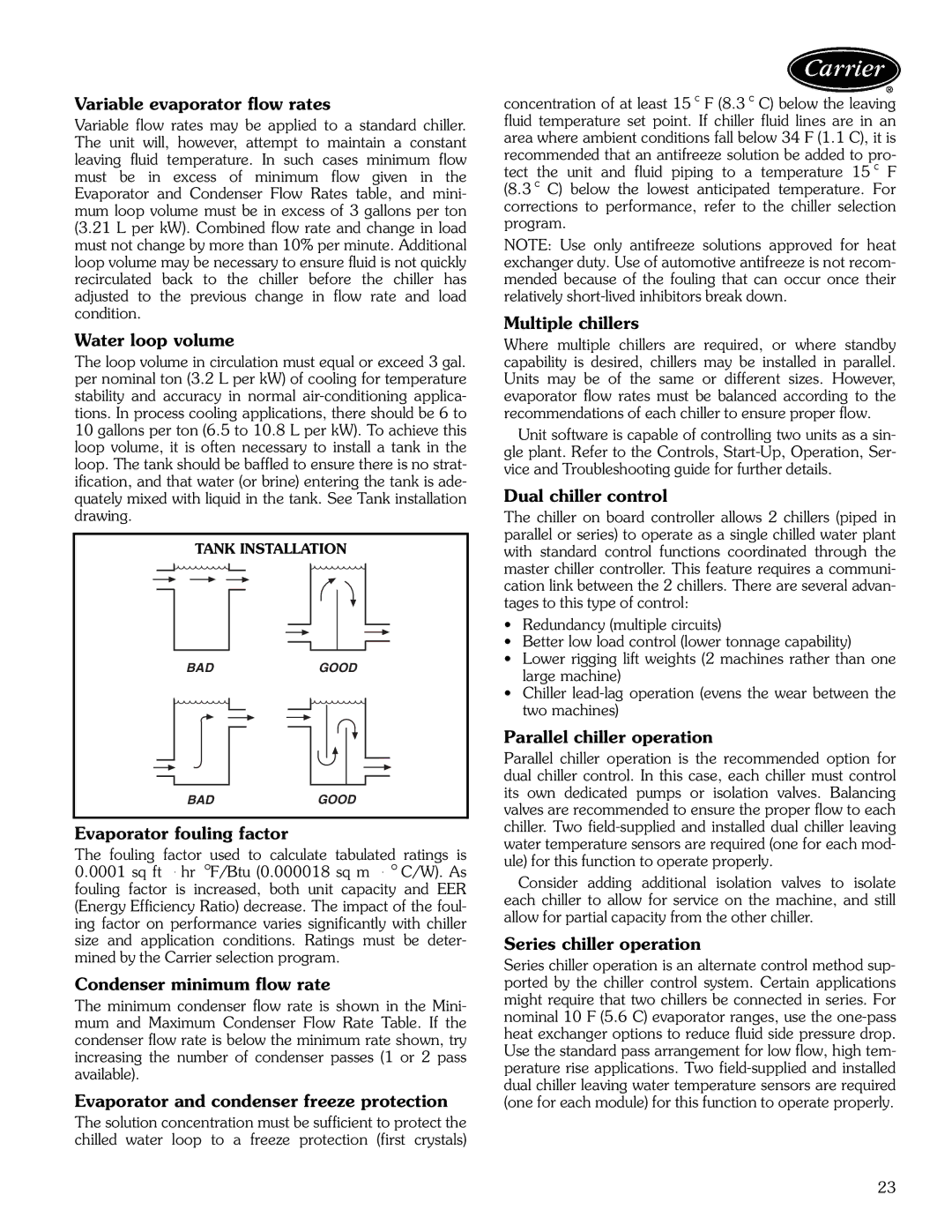
Variable evaporator flow rates
Variable flow rates may be applied to a standard chiller. The unit will, however, attempt to maintain a constant leaving fluid temperature. In such cases minimum flow must be in excess of minimum flow given in the Evaporator and Condenser Flow Rates table, and mini- mum loop volume must be in excess of 3 gallons per ton (3.21 L per kW). Combined flow rate and change in load must not change by more than 10% per minute. Additional loop volume may be necessary to ensure fluid is not quickly recirculated back to the chiller before the chiller has adjusted to the previous change in flow rate and load condition.
Water loop volume
The loop volume in circulation must equal or exceed 3 gal. per nominal ton (3.2 L per kW) of cooling for temperature stability and accuracy in normal
TANK INSTALLATION
BADGOOD
BAD
Evaporator fouling factor
The fouling factor used to calculate tabulated ratings is 0.0001 sq ft hr °F/Btu (0.000018 sq m ° C/W). As fouling factor is increased, both unit capacity and EER (Energy Efficiency Ratio) decrease. The impact of the foul- ing factor on performance varies significantly with chiller size and application conditions. Ratings must be deter- mined by the Carrier selection program.
Condenser minimum flow rate
The minimum condenser flow rate is shown in the Mini- mum and Maximum Condenser Flow Rate Table. If the condenser flow rate is below the minimum rate shown, try increasing the number of condenser passes (1 or 2 pass available).
Evaporator and condenser freeze protection
The solution concentration must be sufficient to protect the chilled water loop to a freeze protection (first crystals)
concentration of at least 15 ° F (8.3 ° C) below the leaving fluid temperature set point. If chiller fluid lines are in an area where ambient conditions fall below 34 F (1.1 C), it is recommended that an antifreeze solution be added to pro- tect the unit and fluid piping to a temperature 15 ° F (8.3 ° C) below the lowest anticipated temperature. For corrections to performance, refer to the chiller selection program.
NOTE: Use only antifreeze solutions approved for heat exchanger duty. Use of automotive antifreeze is not recom- mended because of the fouling that can occur once their relatively
Multiple chillers
Where multiple chillers are required, or where standby capability is desired, chillers may be installed in parallel. Units may be of the same or different sizes. However, evaporator flow rates must be balanced according to the recommendations of each chiller to ensure proper flow.
Unit software is capable of controlling two units as a sin- gle plant. Refer to the Controls,
Dual chiller control
The chiller on board controller allows 2 chillers (piped in parallel or series) to operate as a single chilled water plant with standard control functions coordinated through the master chiller controller. This feature requires a communi- cation link between the 2 chillers. There are several advan- tages to this type of control:
•Redundancy (multiple circuits)
•Better low load control (lower tonnage capability)
•Lower rigging lift weights (2 machines rather than one large machine)
•Chiller
Parallel chiller operation
Parallel chiller operation is the recommended option for dual chiller control. In this case, each chiller must control its own dedicated pumps or isolation valves. Balancing valves are recommended to ensure the proper flow to each chiller. Two
Consider adding additional isolation valves to isolate each chiller to allow for service on the machine, and still allow for partial capacity from the other chiller.
Series chiller operation
Series chiller operation is an alternate control method sup- ported by the chiller control system. Certain applications might require that two chillers be connected in series. For nominal 10 F (5.6 C) evaporator ranges, use the
23
